“Molding Teflon is not a straightforward process; its high melting point and non-stick characteristics pose unique challenges. It requires an understanding of material science and specialized equipment to achieve the desired result.”
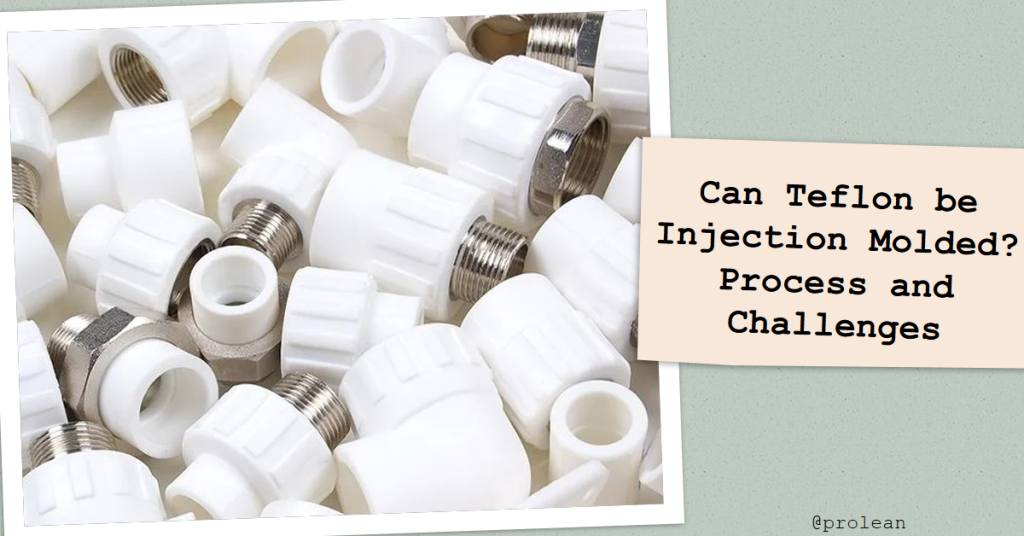
Teflon is a trademark for polytetrafluoroethylene (PTFE). It is renowned for its exceptional non-stick properties and ability to resist high temperatures and chemicals. These properties make it valuable across various industries. But, the question is,” Can Teflon be Injection Molded?”. It opens a discussion about the complexities and technicalities of injection molding materials and processes in the context of Teflon.
This article will discuss the different aspects of Teflon injection molding, revolving around the challenges, process, applications, and alternatives.
Teflon and It’s Unique Properties
Teflon was accidentally discovered in 1938 by chemist Roy Plunkett. Then, it has been part of various industries due to its unique properties, from cookware coatings to aerospace components. Understanding Teflon’s chemical composition and characteristics helps to tackle the impact and the complexities involved in its molding process.
Chemical Composition and Characteristics
Teflon belongs to the family of fluoropolymers, each carbon atom bonded to two fluorine atoms. This strong carbon-fluorine bond is the reason for high thermal stability and resistance to solvents, acids, and bases. The molecular structure of Teflon results in low coefficients of friction among solids, leading to its famous non-stick characteristic.

Chemical structure of PTFE(Teflon)
Additionally, Teflon is highly resistant to heat, with a melting point of about 327°C (620°F). This property makes it suitable for applications involving extreme temperatures. Next, Teflon’s high dielectric strength makes it an excellent electrical insulator.
Another notable characteristic of Teflon is its hydrophobic nature (repels water). This quality, combined with its non-reactive nature, makes Teflon ideal for use in environments where purity and contamination prevention are essential. The material’s ability to withstand environmental aging and UV radiation further contributes to its durability and long-term performance in various applications.
Can Teflon be Injection Molded? The Answer
Injection molding is a popular method for shaping thermoplastics. Its efficiency and ability to produce complex shapes with high precision make it an effective method in plastic manufacturing. However, Teflon presents unique challenges that make its compatibility with standard injection molding processes, a subject of technical debate and innovation.
What Makes Teflon Injection Molding Challenging?
The primary challenge in molding Teflon arises from its very nature. Teflon has a high melting point (about 327°C or 620°F) and does not flow like typical thermoplastics used in injection molding. When heated to its melting point, it does not enter a liquid state but becomes a gel-like substance. Furthermore, this gel phase makes it difficult to control during the injection molding. It does not easily fill the mold cavities with the same fluidity as other plastics.
Additionally, non-stick characteristics can prevent the injection molding raw material from adhering to the mold surfaces properly, affecting the integrity and dimensional accuracy of the molded parts. Moreover, the rapid cooling of Teflon post-molding can lead to material shrinkage and warping, further complicating the molding process.
Yes! Teflon Can be Injection Molded
In response to “Can Teflon be Injection Molded?”, the answer is Yes! It is one of the common injection molding materials. Despite these challenges, advancements in material processing and mold design have led to innovative methods that can facilitate the molding of Teflon. These include modifications to traditional injection molding equipment, specialized mold designs to accommodate Teflon’s properties, and more compatible Teflon-grade development.
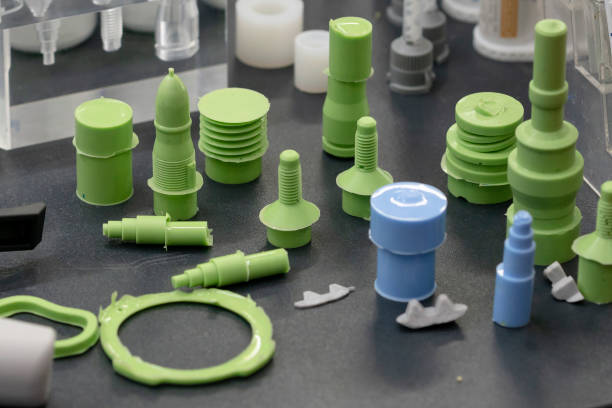
Injection-molded Teflon parts
At the time, advancements and specialized techniques have made injection molding of Teflon more feasible. However, the complexity and cost factors associated with these specialized methods make Teflon injection molding still not as commonplace as other thermoplastics unless it is absolutely necessary.
Related: Why is CNC Machining Better than Injection Molding for Thermoplastic Prototyping?
Try Prolean Now!
Why PTFE Cannot be Traditionally Molded?
The traditional techniques commonly used for other plastics often fall short of PTFE(Teflon). PTFE’s high melting point, non-stick nature, and particular behavior under heat present significant challenges to standard molding equipment and procedures. To successfully mold PTFE, specialized equipment and customized molds are necessary. These tailored solutions accommodate distinct physical and chemical characteristics of Teflon.
The Necessity of Specialized Equipment for PTFE Molding
Specialized equipment designed for PTFE molding typically includes advanced temperature control systems that can precisely manage the high heat required to bring PTFE to its gel state. Additionally, this equipment handles the material’s tendency to expand and contract significantly during the heating and cooling phases.
Moreover, PTFE’s release of gases at high temperatures necessitates equipment that can safely vent these emissions. , There are geese related to health and environmental concerns like perfluorooctanoic acid (PFOA).
Customized Molds for PTFE Injection Molding
Alongside specialized equipment, customized molds are critical for successfully molding PTFE(Teflon). Customized molds for PTFE often incorporate specific surface treatments or coatings that can temporarily interact with PTFE, ensuring better shape fidelity. Additionally, these molds accommodate thermal expansion and contraction of Teflon, which is more pronounced than in other plastics. It involves precise calculations and design considerations to ensure the final product has the desired dimensions and tolerances.
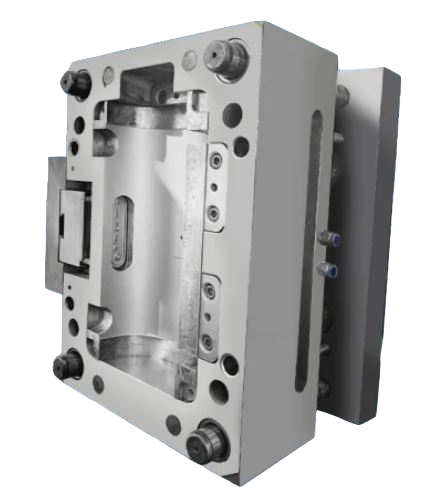
Custom mold for Teflon molding
Another aspect of customized mold design for PTFE involves advanced release mechanisms. Given PTFE’s tendency to not stick, removing the finished product from the mold can be challenging. Customized molds may include specialized release angles and surfaces that facilitate the easy removal of the molded PTFE part without damaging its surface or altering its dimensions.
Related: Aluminum Injection Molds for Efficient Manufacturing
The Process of Teflon Injection Molding
Injection molding of Teflon is a complex process that requires customized equipment, precise temperature control, and expert handling to transform Teflon powder into intricately shaped parts.
Let’s discuss the stepwise procedure of Teflon injection molding:
Step 1: Material Preparation
The process begins with the preparation of PTFE powder, rather than pellets or granules commonly used for other plastics. This powder must have a specific particle size to ensure uniform flow during the molding process.
In addition, moisture content is crucial and the powder is often pre-dried to prevent any steam or gas formation during heating, which can cause defects in the final product.
Step 2: Performing
The next step is performing, where the Teflon powder is compressed into a preform or a rough shape close to the final product. This is typically done using a cold compression process in a specially designed mold.
The preform, while still in a solid state, is carefully handled to maintain its shape and integrity. This step is crucial as it prepares the Teflon for the precise and uniform heating required in the subsequent stages of the molding process.
Step 3: Sintering
Sintering is a critical phase in Teflon injection molding. Unlike traditional plastics, Teflon does not melt into a liquid but instead transitions to a gel-like state at high temperatures. The preformed Teflon is placed in a sintering oven where it is heated above its melting point.
This process allows the Teflon particles to fuse together, forming a solid, cohesive mass. The temperature and duration of the sintering process are carefully controlled to ensure the Teflon part achieves the desired strength and material properties.
Step 4: Cooling and Ejection
After sintering, the Teflon part needs to be cooled carefully and uniformly to avoid any warping or internal stresses. This cooling process is slower compared to other plastics due to Teflon’s unique thermal properties. Once the part has cooled down and solidified, it is ejected from the mold.
Step 5: Post-processing
The final step in Teflon injection molding is post-processing. This can include machining, drilling, or cutting to achieve the precise dimensions and tolerances required for the part. Some common surface finishing processes for Teflon parts are sandblasting, polishing technique, coating, etc.
Six Tips for Teflon Injection Molding
Teflon injection molding can be successfully handled with the right approach and understanding of the material’s unique properties. It presents specific challenges in injection molding due to its high melting point, non-stick nature, and absence of a true liquid state under heat. So, the Teflon injection molding demands mold with high thermal insulation and compressive strength. Source.
The following are the Six Tips for Teflon Injection Molding:
- Teflon requires strict temperature management during molding. Ensure the temperature is consistent and accurate to avoid material degradation.
- Due to Teflon’s unique properties, standard injection molding machines may not be suitable. Use equipment designed specifically for high-temperature polymers.
- Examine the quality of the Teflon powder since it significantly impacts the final product. Ensure the powder is dry and of uniform particle size.
- Custom mold designs are necessary for Teflon. These should accommodate its thermal expansion and non-stick properties to reduce defects and facilitate easy ejection.
- Cool the mold slowly and uniformly to prevent warping and stress. Implement a controlled cooling process in the mold design.
- Maintain a clean and controlled environment throughout the molding process to avoid contamination.
Try Prolean Now!
Alternative Molding Methods for Teflon
Given the inherent challenges in injection molding Teflon (PTFE), alternative molding methods have been developed to better harness this material’s unique capabilities. These alternatives overcome the limitations of traditional molding techniques. Some notable alternative methods include compression molding, ram extrusion, and isostatic molding. These techniques offer distinct advantages and are suitable for different types of Teflon parts and applications.
1. Compression Molding
Compression molding is a technique primarily used for plastics like Teflon. In this process, the material is first placed in an open, heated mold cavity. The mold is then closed, applying pressure to force the material to conform to the shape of the mold. This method is particularly suited for high-strength, high-precision components.
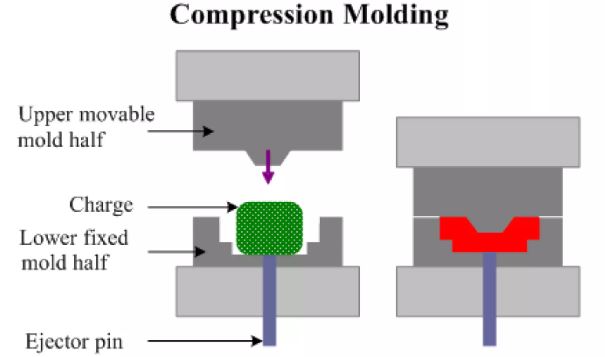
Compression molding
In the Teflon compression molding, the Teflon powder is compressed under high pressure and heat. The heat causes the material to sinter and bond without reaching a liquid state. The applied pressure ensures uniformity in the part, and once the cycle is complete, the part is cooled and removed from the mold.
Advantages and Applications
- High-Dimensional Accuracy: Ideal for creating parts with tight tolerances.
- Excellent Material Properties: Yields parts with uniform density and strength.
- Cost-Effectiveness: Lower production costs for medium to large batch sizes.
- Applications: Commonly used in making large electrical insulators, automotive parts, and various industrial components.
2. Ram Extrusion
Ram extrusion is a process tailored for producing continuous lengths of a material, especially suitable for Teflon. The material, in powder form, is forced through a die of a desired cross-section under the influence of a ram. This method is suitable for creating consistent, long products like tubes and rods.
During ram extrusion, the Teflon powder is placed in a chamber where a ram pushes it through a heated die. The material is sintered as it passes through the die, taking on the shape of the desired profile. The continuous extruded product is then cut to length.
Advantages and Applications
- Continuous Production Capability: Suitable for creating long, uniform products.
- Material Efficiency: Minimizes waste, as excess material can be reused.
- Versatility in Shapes: Can produce a variety of cross-sectional profiles.
- Applications: Manufacturing Teflon pipes, rods, and seals used in chemical processing and electrical industries.
3. Isostatic Molding
Isostatic molding is a unique process that applies equal pressure from all directions on a material, typically used for high-precision and high-density components. In this method, the material is enclosed in a flexible mold and subjected to high pressure, often in a fluid medium.
The Teflon isostatic molding involves encasing the Teflon powder in a flexible mold, like rubber. This mold is then placed in a pressure vessel, where it is subjected to isotropic pressure, typically using a fluid. The uniform pressure ensures even density and material properties throughout the part.
Advantages and Applications
- High Density and Uniformity: Produces parts with consistent material properties.
- Ability to Mold Complex Shapes: Suitable for intricate designs and fine details.
- High Quality and Precision: Ensures parts meet strict dimensional tolerances.
- Applications: This material is popular in medical and electronic industries for manufacturing components like filters, pump parts, and connectors.
Applications of Teflon Injection Molding Parts
Industries from aerospace and automotive to electronics rely on Teflon parts for their durability, performance under extreme conditions, and minimal maintenance requirements. The versatility of Teflon injection molding parts is evident in their wide array of applications, demonstrating how this technology meets diverse and demanding industrial needs.

Teflon injection molding parts
Here are the most common specific applications:
- Non-Stick Coatings for Cookware: Resistant to high temperatures and easy to clean.
- Electrical Insulators: High dielectric strength for electrical components.
- Medical Injection Molding Components: Biocompatible parts for medical applications.
- Seals and Gaskets in Aerospace: Heat and chemical-resistant sealing solutions.
- Automotive Hoses and Bearings: Durable under high friction and temperatures.
- Packaging Machinery: Components that endure wear and tear.
- Chemical Processing Equipment: Parts resistant to corrosive substances
- Food Processing Machinery Parts: Non-toxic and easy-to-clean surfaces.
- Semiconductor Manufacturing: Components for cleanroom environments.
- Microwave Cookware: Safe and efficient for microwave use.
- Pumps and Valves: Components that withstand harsh industrial environments\
- Laboratory Equipment: Chemically inert containers and utensils.
Try Prolean Now!
We Mold Teflon Plastic with Competitive Pricing at Prolean
At Prolean, we provide top-tier Teflon injection molding services. We have specialized equipment, a custom mold design and machining facility, and a deep understanding of Teflon’s unique properties. Our team of experts leverages this manufacturing infrastructure technology to ensure that each Teflon part we produce meets the highest standards and performance.
In addition to expertise in Injection Molding Services, Prolean offers alternative solutions to provide our clients with options to suit their specific needs. We also specialize in Teflon CNC machining services, enabling the production of highly precise and complex parts. Our versatility in handling Teflon through various methods allows us to adapt to unique challenges.
Our services at Prolean are comprehensive, covering every aspect of the production process, from mold design to post-processing. At Prolean, we also machine the mold with our advanced CNC machining and EDM machining services. Whether you need a complete end-to-end solution or specific services like mold design or high-precision Teflon parts, we are eager to deliver.
Summing Up
While the Teflon injection molding process presents significant challenges, advancements in technology and material science have made it more efficient, precise, and feasible. Although Teflon’s high melting point and non-stick nature complicate traditional molding methods, the question “Can Teflon be Injection Molded?” now has a more affirmative answer than ever before. Innovations in equipment design, mold customization, and processing methods have made it possible.
However, there are alternative molding techniques for Teflon, such as compression molding and ram extrusion. These methods further broaden the scope of Teflon’s applications across various industries.
FAQs
Can Teflon be injection molded?
Yes, Teflon can be injection molded, but the process is more complex than regular thermoplastics due to its high melting point and unique properties.
What are the primary challenges in molding Teflon?
The primary challenges in molding Teflon include its high melting point, which makes it difficult to achieve the fluid state necessary during injection. Also, its non-stick nature and tendency to emit gases at high temperatures present significant technical hurdles.
How is Teflon typically molded if not by injection?
Teflon can be injection molded. But, there are alternative methods also, like compression molding, ram extrusion, and isostatic molding.
What are the industrial applications of molded Teflon?
The typical applications include non-stick coatings for cookware, electrical insulators, seals, and gaskets in aerospace, components in medical devices, automotive parts, etc.
What recent advances have been made in Teflon molding technology?
Recent advances in Teflon molding technology include the development of specialized molding equipment and molds.
Resources
- NES. (2018, July 3). Teflon Vs PTFE: What Really Are The Differences? Retrieved from https://www.ncbi.nlm.nih.gov/pmc/articles/PMC6728502/
- Fetecau, C., & Stan, F. (2012). Study of cutting force and surface roughness in the turning of polytetrafluoroethylene composites with a polycrystalline diamond tool. Measurement, 45(6), 1367-1379. https://doi.org/10.1016/j.measurement.2012.03.030
- Science History Institute. (2023). Roy J. Plunkett. Retrieved from https://www.sciencehistory.org/education/scientific-biographies/roy-j-plunkett



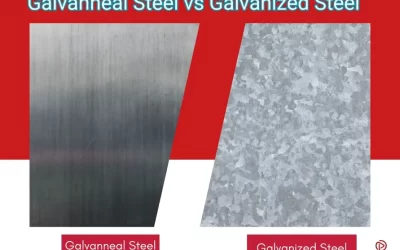
Thanks for detailed article! Isn’t it better to compression mold the teflon than facing so much hurdles in Teflon injection molding?
Lucas, sometimes compression molding can not achieve the desired specification and properties of teflon parts, so wee need to consider teflon injection molding. Infact, both molding methods have own benefits and drawbacks for teflon molding.
Finally, i got what i needed. Teflon are not only challenging to mold but also learn